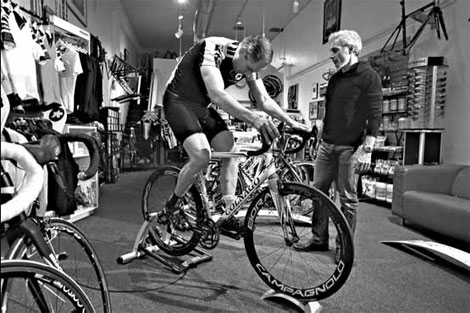Where wealth is consumed inconspicuously
 |
|
For the millionaires of Silicon Valley, Italian racing bicycles are the new Ferraris. VeloTech Cycles, a high-end bike store in Palo Alto. Jim Wilson / The New York Times |
MENLO PARK, California - Here in one of the richest corners of the country, the tech elite display an ambivalent, sometimes contradictory approach to wealth. Money, as one scholar of Silicon Valley described it, is treated as a measuring stick, gauging the power of the companies that entrepreneurs have built, rather than a thing to display.
"They use it as a way of keeping score - how disruptive can you be in reordering the market," said Ted Zoller, a fellow at the Ewing Marion Kauffman Foundation who studies entrepreneurship.
Make no mistake. In this, Silicon Valley's gilded age, money is chasing money. Lucrative salaries and stock options are dangled to recruit or hold onto engineers. The shares of established companies like Apple have soared. And Facebook has turned to Wall Street for a vast infusion of fresh funds.
Money still matters deeply to this crowd. "It is a means to do more, to make more money and ultimately build more," Mr. Zoller said.
The one money matter that most Internet millionaires talk about openly is what start-ups they are investing in next. Expect many more such investments from Facebook executives.
Indeed, that might be where the biggest chunk of Facebook executives' new wealth will go.
(Although Facebook's stock declined after the company went public on May 18, Mr. Zuckerberg is now worth about $15 billion.)
Off the corporate campuses and out of public view, it seems, there is little anxiety about spending. Friends of Facebook employees say that they have talked about buying houses, of course, but also planes and works by popular artists like Banksy, whose pieces can sell for hundreds of thousands of dollars.
To understand the contradictions of moneymaking in the Valley, it is instructive to look at another landmark public offering: Google in the summer of 2004. Just before it went public, a senior manager holding a baseball bat lectured employees: anyone who dared show up to work in a flashy sports car would soon find its windows shattered. But it is also well known that the company's three top executives have a collection of eight private jets.
Some tech celebrities, of course, are known for being flashy. Fabulous home theaters are tucked into the basements of plain suburban houses. The hand-painted Italian bicycles that flash across Silicon Valley on Saturday mornings are the new Ferrari - and only the cognoscenti could imagine that they cost more than $20,000.
Both Lawrence J. Ellison, chief executive of Oracle, and Sean Parker, an early Facebook executive, have storied, lavish lifestyles. And Sheryl Sandberg, Facebook's chief operating officer, is building a house in exclusive Menlo Park - much of it underground, hidden from view.
Mark Zuckerberg, Facebook's chief executive, sets the tone at the company with his trademark rumpled hoodies. He spent $7 million on a large but nondescript home in Palo Alto, a suburb so expensive that even a small, no-frills house easily goes for $1.5 million.
In a letter to would-be shareholders when the company filed to go public, Mr. Zuckerberg summed up his corporate philosophy: "Simply put, we don't build services to make money; we make money to build better services."
It is understood, say Facebook employees, that Mr. Zuckerberg would not approve of his underlings driving a Lamborghini to the office.
"It's almost an unspoken rule: spend your money, but do it privately," said one person who knows Mr. Zuckerberg and others at Facebook socially.
Andrew Rachleff, a wealth manager, estimated that the Facebook offering created around 1,000 millionaires, most of whom made something in the $2 million to $5 million range. Much of the money he has gathered so far for his company, Wealthfront, is from young techies at firms like Google, LinkedIn and Facebook.
Mr. Rachleff's aim is to reach out to that Valley demographic - young, good at math, uncomfortable with professional money managers - and make their money grow. He has already run into a glitch: "They all hate that word, 'wealth.'"
The share of wealthy households in Silicon Valley is growing, according to the United States census. Nearly 14 percent of all households in Santa Clara and San Mateo Counties earn more than $200,000 a year, just below the 16 percent of households in Manhattan.
Still, many here make an effort to distinguish themselves from the much maligned coterie of bankers and other members of the 1 percent in places like New York and Boston. Wingtips and silk ties are rare. Cycling and kite-boarding are preferred over golf.
Bill Gurley, a venture capitalist in Menlo Park, recalls when he began working as a Wall Street analyst in Manhattan in 1993. "My first day at work," he said, "I was told to replace all my ties with Hermes and never to wear brown shoes again."
He did not last long on Wall Street. He is a partner now at Benchmark Capital, which recently profited handsomely from Facebook's $1 billion acquisition of Instagram.
Here in the Silicon Valley, those Hermes ties would be a liability. "If someone buys a fancy car and posts a picture of it," said a Facebook executive, "they get ridiculed and berated."






















